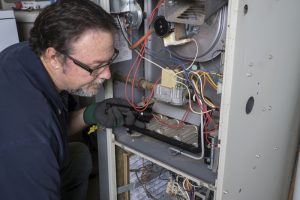 Okay, nobody wants a furnace problem at all. But there is one in particular that should be avoided more than the rest due to the potential hazard it brings—and that is a cracked heat exchanger.
Okay, nobody wants a furnace problem at all. But there is one in particular that should be avoided more than the rest due to the potential hazard it brings—and that is a cracked heat exchanger.
If your home is like the majority in Salt Lake City, it’s very likely that you’re using a gas-powered furnace to heat your home. Gas furnaces not only provide a large amount of heat, but they do so at less expense than electric heating systems, since natural gas costs less than electricity per unit.
But any natural-gas appliance, while built with safety features and customer safety in mind, has the potential to develop hazards. We don’t say this to alarm you, especially if your furnace is well maintained and on the newer side. However, we definitely do want you to be aware of the danger of a cracked heat exchanger.
“Wait, What’s a Heat Exchanger?”
Good question! It is essentially what enables the furnace to heat up the air that travels through your ventilation system. When the burners of the furnace come up, they generate hot combustion gas, which is collected inside the heat exchanger—a metal chamber or series of chambers. Most of them have a clam-shell shape where the combustion gas heats up.
The blower fan of your furnace comes on and sends air around the heat exchanger, and then picks up the heat from the furnace wall, and sends the warm air through the ducts. In this process, the combustion gas heats the air without the gas ever coming into contact with your indoor air. And once the heating process is complete, the combustion byproducts in the heat exchanger are vented out of the system through a flue to release the gas harmlessly into the air.
The Problem with a Cracked Heat Exchanger
This is a problem more likely to impact aging furnaces than newer ones, but it is still worth mentioning. Due to the metal of the heat exchanger expanding and contracting with the heat, the stress eventually causes a crack to form on the exchanger.
Corrosion occurs, due to the reaction between the combustion gas and the metal (often because of improper venting), which can weaken the metal to the point that it cracks.
The cracks are often small—invisible to the naked eye—but as the exchanger expands with the heat, the cracks open enough to allow some of the combustion gasses to escape and enter the airflow. This means that these harmful gasses will be sent through your home.
Do I Have a Cracked Heat Exchanger?
A major warning sign that you do, in fact, have a cracked heat exchanger is if you hear a clicking sound coming from the furnace soon after the blower shuts off. This should always be investigated—by a pro! But if you visually notice any corrosion anywhere, it’s a sign that this is what’s probably occurring, and it’s likely time to replace the furnace. Cracked heat exchangers and corrosion usually don’t occur with furnaces that are younger than 15 years of age, so long as they are properly maintained.
For expert Salt Lake City heating repair and more, contact Design Comfort today!


